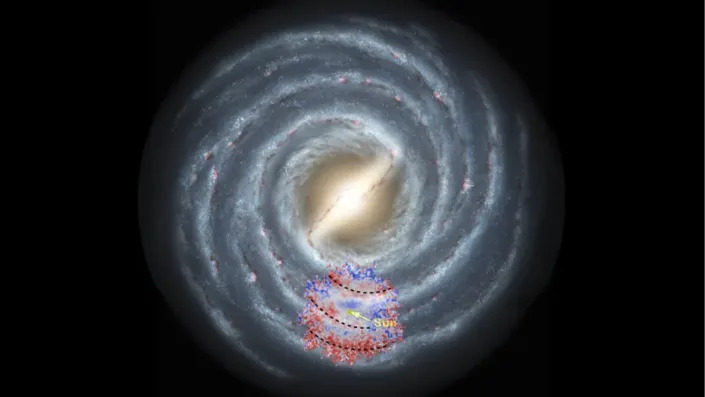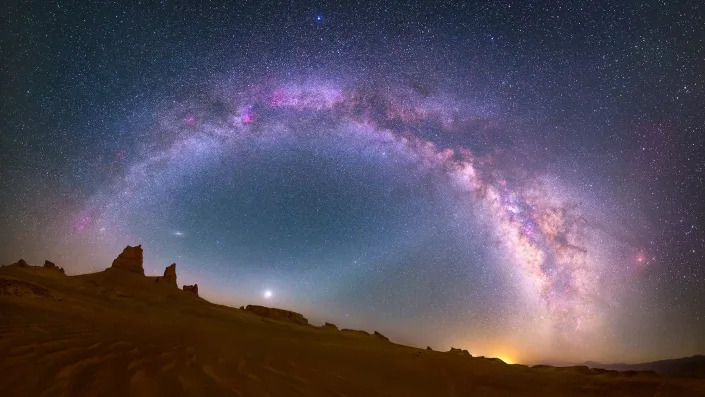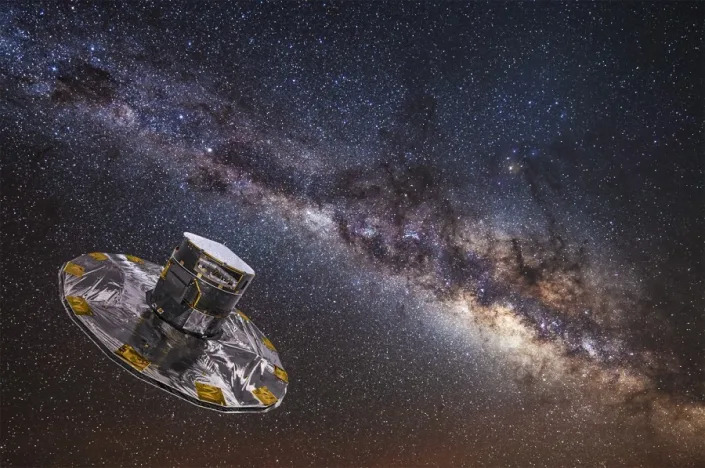Robert Lea
SPACE
Wed, July 26, 2023

An illustration of the Milky Way with red and blue spots showing areas with few (blue) and many (red) heavy elements
Never-before-seen details of the Milky Way's spiral arms have been revealed through chemical mapping.
This pioneering technique, called chemical cartography, has unveiled new regions of our galaxy's stunning radial features populated by dense patches of young stars. Headed by Keith Hawkins, an assistant professor at The University of Texas at Austin, the research team's work could be crucial for astronomers seeking to understand our galaxy's evolution, shape and structure.
Chemical cartography shows the distribution of elements throughout the Milky Way — from lighter elements, such as hydrogen and helium, to heavier ones, such as carbon, nitrogen and oxygen. For context, astronomers refer to any elements heavier than helium as metals. This, therefore, allows astronomers to locate stars according to their chemical compositions rather than merely the light they emit.
Over the course of their lives, stars fuse hydrogen to create helium, then fuse that helium to create other metals. This means metal levels associated with individual stars can give astronomers information about their ages. Chemical cartography thus allowed Hawkins and fellow scientists to spot where the Milky Way's young stars are concentrated. In short, the researchers found them to be abundant in our galaxy’s spiral arms.
Related: Alien's-eye view of the Milky Way: Our galaxy is unusual but not unique
"Much like the early explorers, who created better and better maps of our world, we are now creating better and better maps of the Milky Way," Hawkins said. "Those maps are revealing things we thought to be true but still need to check."
Chemical cartography isn't really a new process, but only recently did scientists manage to develop telescopes with enough observing power to get significant results using the technique.
Finding where the Milky Way's hot young stars hang out
For at least seven decades, astronomers have understood that our galaxy has spiral arms that extend out from the dense concentration of stars, gas, and dust which lie at its heart, known as the "central bulge."
However, the exact shape of this striking structure — down to the number of arms our galaxy has — remains uncertain.
The difficulty in assessing the Milky Way's morphology comes from the fact that we live in it. We're basically analyzing it from the inside, with Earth sitting in the Orion Arm around two-thirds of the way from the central bulge.
We simply can't get far enough to observe our galaxy from an outsider's perspective.
"It's like being in a big city," Hawkins explained. "You can look around at the buildings and you can see what street you’re on, but it’s hard to know what the whole city looks like unless you’re in a plane flying above it."
This hasn't prevented scientists from modeling intricate models of the shape of the Milky Way, but Hawkins wanted to verify the accuracy of those models while simultaneously investigating whether chemical cartography can offer an even better view of the Milky Way's arms in general.
Wed, July 26, 2023

An illustration of the Milky Way with red and blue spots showing areas with few (blue) and many (red) heavy elements
Never-before-seen details of the Milky Way's spiral arms have been revealed through chemical mapping.
This pioneering technique, called chemical cartography, has unveiled new regions of our galaxy's stunning radial features populated by dense patches of young stars. Headed by Keith Hawkins, an assistant professor at The University of Texas at Austin, the research team's work could be crucial for astronomers seeking to understand our galaxy's evolution, shape and structure.
Chemical cartography shows the distribution of elements throughout the Milky Way — from lighter elements, such as hydrogen and helium, to heavier ones, such as carbon, nitrogen and oxygen. For context, astronomers refer to any elements heavier than helium as metals. This, therefore, allows astronomers to locate stars according to their chemical compositions rather than merely the light they emit.
Over the course of their lives, stars fuse hydrogen to create helium, then fuse that helium to create other metals. This means metal levels associated with individual stars can give astronomers information about their ages. Chemical cartography thus allowed Hawkins and fellow scientists to spot where the Milky Way's young stars are concentrated. In short, the researchers found them to be abundant in our galaxy’s spiral arms.
Related: Alien's-eye view of the Milky Way: Our galaxy is unusual but not unique
"Much like the early explorers, who created better and better maps of our world, we are now creating better and better maps of the Milky Way," Hawkins said. "Those maps are revealing things we thought to be true but still need to check."
Chemical cartography isn't really a new process, but only recently did scientists manage to develop telescopes with enough observing power to get significant results using the technique.
Finding where the Milky Way's hot young stars hang out
For at least seven decades, astronomers have understood that our galaxy has spiral arms that extend out from the dense concentration of stars, gas, and dust which lie at its heart, known as the "central bulge."
However, the exact shape of this striking structure — down to the number of arms our galaxy has — remains uncertain.
The difficulty in assessing the Milky Way's morphology comes from the fact that we live in it. We're basically analyzing it from the inside, with Earth sitting in the Orion Arm around two-thirds of the way from the central bulge.
We simply can't get far enough to observe our galaxy from an outsider's perspective.
"It's like being in a big city," Hawkins explained. "You can look around at the buildings and you can see what street you’re on, but it’s hard to know what the whole city looks like unless you’re in a plane flying above it."
This hasn't prevented scientists from modeling intricate models of the shape of the Milky Way, but Hawkins wanted to verify the accuracy of those models while simultaneously investigating whether chemical cartography can offer an even better view of the Milky Way's arms in general.

The arch of Milky Way shining bright above Lut desert, in Kerman, Iran.
RELATED STORIES:
— Gaia spacecraft: Mapping the Milky Way like never before
— New Milky Way map reveals the magnificent messiness of our galaxy
— The Milky Way galaxy may be a different shape than we thought
One traditional way of mapping the Milky Way involves monitoring the concentrations of young stars that are created as the galaxy's very dense spiral arms rotate. As this rotation occurs, it compresses gas and dust to ultimately trigger star births.
In other words, identifying an overabundance of young stars implies the location of a spiral arm.
Though young stars can be detected by tracking the bright blue light they emit, observations of this kind can be obscured by thick clouds of dust which present a challenge to even the most advanced telescopes. That means some regions of the Milky Way’s spiral arms go unobserved.
No more metal
One way of working around this dust veil is by observing exactly how metal-rich the stars that lurk in hidden regions are.
This so-called metalicity serves as an age measurement because the early cosmos was filled with hydrogen and helium, but little in the way of metals. That means the oldest stars are also composed of mostly hydrogen and helium and are thus "low metalicity" or "metal-poor."
During their lives, these older stars forge heavier elements via nuclear fusion — but when they run out of such fuel, are ripped apart by supernova explosions that spread the metals throughout their cosmic environment. Therefore, when metal-enriched clouds of dust and gas collapse to birth stars, this next generation of stars is richer in metals than the last.
This stellar cycle of life and death has continued throughout the 13.8 billion-year history of the universe, with every subsequent generation of stars being more metal-rich than the last. Thus, young stars are expected to be "metal-rich" or hold a "high metalicity."
If the Milky Way's spiral arms trigger star births as predicted, then they should be marked by young stars, aka metal-rich stars. Conversely, spaces between the arms should be marked by metal-poor stars.
To confirm this theory, as well as create his overall map of metalicity, Hawkins first looked at our solar system's galactic backyard, which include stars about 32,000 light years from the sun. In cosmic terms, that represents our stellar neighborhood's immediate vicinity.
Taking the resultant map, the researcher compared it to others of the same area of the Milky Way created by different techniques, finding that the positions of the spiral arms lined up. And, because he used metalicity to chart the spiral arms, hitherto unseen regions of the Milky Way's spiral arms showed up in Hawkins' map.
"A big takeaway is that the spiral arms are indeed richer in metals," Hawkins explained. "This illustrates the value of chemical cartography in identifying the Milky Way's structure and formation. It has the potential to fully transform our view of the Galaxy."
The future is bright for chemical cartography
To reach his conclusions, Hawkins used data from the Large Sky Area Multi-Object Fibre Spectroscopic Telescope (LAMOST) and the Gaia space telescope, with new data from the latter proving particularly useful.
Since Gaia launched in 2013, the spacecraft has observed around 2 billion cosmic objects allowing astronomers to considerably widen their view of the universe. It dropped its latest and third data release in June 2022, which was especially important for Hawkins’ chemical cartography because it offers the most precise and comprehensive survey of the Milky Way ever conducted.
"The sheer volume of data available from Gaia allows us to do chemical cartography at a galactic scale now," Hawkins said. "Data on both the positions for billions of stars and their chemical makeup wasn’t available until recently."
But as impressive as Gaia’s chemical data is, its observations still represent just around 1% of the Milky Way. Going forward, not only will Gaia continue to scour our galaxy collecting this data, but new telescopes are also coming online to collect data ripe for chemical cartography endeavors.

a disc-shaped spacecraft in space
As telescope technology becomes more advanced, the power of chemical cartography will also increase, meaning astronomers stand to learn more about the structure of our galaxy and its previously obscured regions.
The Milky Way and its chemical composition will thus deliver insights that can be applied to other galaxies, with this new map offering a hint at the revelations that are yet to come.
“It’s a completely new era,” Hawkins concluded.
The team's research was published in the April issue of the journal Monthly Notices of the Royal Astronomical Society.
No comments:
Post a Comment